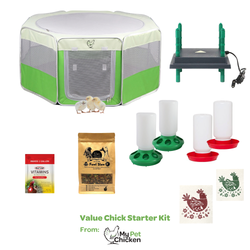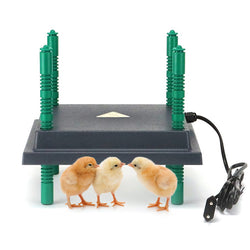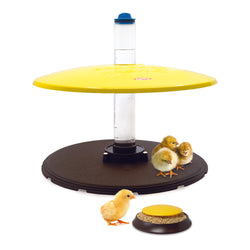Top Reasons to Raise Chicks in the Fall
Back to blog
Raising chicks in fall has some significant advantages, including better breed availability, larger eggs, and early spring egg production. Spring is the traditional time to begin raising baby chicks. But in the past, chickens simply laid fewer eggs than they do today. Their top laying season was spring, so more eggs were available for hatching. Modern chicken breeds tend to be selected for higher production and near-year-round laying. This lets us choose to raise chicks almost any time of year.
Raising baby chicks in the fall can have several advantages, including:
Top Reasons to Raise Chicks in Fall
- Early Spring Egg Production: When raising fall chicks, your pet chickens will be at the right age to begin laying the following spring. They lay wonderfully once they start since it's seasonal for them to lay more eggs in spring as the days are growing longer. Each young bird could lay as many as seven eggs a week if you've chosen breeds with excellent layers, such as the Rhode Island Red, the Australorp, and the Speckled Sussex. But even breeds that are fair or poor layers will be laying at their top speed. And believe me, those first backyard eggs you get from your flock will be the best you've ever tasted! You'll probably be eating more eggs, not only because you'll have so many, but because they're so delicious! So having your chickens laying lots of eggs is lovely since you'll have plenty to use.
- Larger Eggs: A second significant advantage you get when you raise chicks in fall is that--if you start them in early fall--their laying is delayed until your birds reach a larger size in spring. While you'd initially consider this a disadvantage, they will generally lay larger eggs throughout their lives. They may also lay more consistently when they experience increasing daylight at the right age.
- Better Rare Breed Availability: Have you had your eye on a rare breed chicken that you MUST add to your backyard chicken flock? Since raising chicks in spring is the traditional time, finding inventory and getting that special breed you have wanted can sometimes be challenging. Raising chicks in fall offers better availability of many rare chicken breeds. Some of our favorite rare chicken breeds that are more available in the fall months are Ayam Cemanis, Marans, Silked White Easter Eggers, and Blue/Black/Splash Orpingtons.
- Avoiding Summer Heat Stress: By raising chicks in fall, you can avoid the challenge of managing chicks during the hot summer months when they are more susceptible to heat stress. In many regions, fall offers milder and more stable weather compared to the scorching heat of summer or the bitter cold of winter. This can make it more comfortable for both the chicks and the caretaker.
- Reduced Risk of Disease: Fall typically decreases the prevalence of certain poultry diseases and parasites, such as coccidiosis, which can thrive in warm and wet conditions. This can result in healthier chicks.

Tips for Raising Chicks in the Fall
- Choose Cold-Hardy Breeds: Select chicken breeds that are known for their cold-hardiness. Some examples include Easter Eggers, Plymouth Rocks, Orpingtons, and Wyandottes. These breeds tend to handle cooler temperatures better due to their body type and comb styles.
- Provide Adequate Heat: When raising chicks in fall, it's important to remember to be prepared to provide temporary supplemental heat. This will help your young birds transition to cold outside weather. Chicks need a warm environment to thrive. Use a heating plate to maintain a temperature of around 95°F for the first week and then gradually reduce it by 5°F per week until they are fully feathered and can regulate their own body temperature.
- Start Outdoor Exploration Gradually: As your fall chicks grow and the weather permits, gradually introduce them to the outdoors during the daytime. Monitor them closely and bring them back inside if it gets too cold. Be sure to keep them in a predator-safe structure for their outside exploration time.
- Plan for Winter Housing: Make sure you have a suitable chicken coop or shelter ready for your fall chicks as they grow. They will quickly outgrow the brooder and need a safe and warm living place. Ensure that their coop is well-insulated and draft-free, with proper heating if necessary. We also recommend adding an extra layer of bedding material to their coop to provide extra warmth.
- Protect from Predators: Be vigilant about protecting your fall chicks from potential predators, which may be more active in the fall. Due to their smaller size, younger birds are more susceptible to attacks than older and more experienced chickens. Consider installing an automatic coop door for an extra layer of predator protection
Raising chicks in fall can be a bit more challenging than in the spring or summer, but with the right preparations and attend to their needs, you can raise healthy chickens that will thrive and provide you with fresh spring eggs!
If you are looking for tips on how to raise baby chicks, check out our free Chicken Care Guide. We share all the tips and tricks we have gathered from our years of experience to make raising chicks easy.




1 comment
At what age can chicks start getting dried meal worms and other snacks cabbage etc?
———
My Pet Chicken:
Chicks can start having dried mealworms and other snacks like cabbage at around 3-4 weeks old. Be sure treats are no more than 10% of their diet, with the rest being chick starter feed. Also, offer chick grit to help with digestion when giving solid treats.